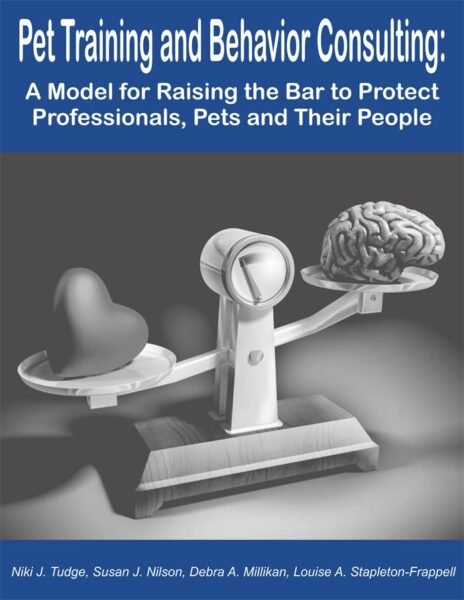Pets and Their People Blog

Is There a Dog in the House? Keeping Kids Safe at Playdates and Childcare
A Doggone Safe Playdate Checklist As I was exploring the Doggone safe free public resources, I smiled when I realized how many excellent resources there are to use and share. One of my favorites is “Play Dates and Babysitter’s House.” This resource features basic questions a parent should be asking to keep their child safe, like: A parent would ask these and many more questions of a prospective in-home daycare or nanny. Rarely does it occur to a parent to ask if the family has a dog and, if so, what… Continued
Sudden Tension Between Cats: Could It Be Non-Recognition Aggression?
Each year, countless cats and their guardians are affected by non-recognition aggression, a phenomenon in which a cat returning home from an outing is suddenly treated as an intruder by a cat who remained at home. This situation often occurs after a visit to the vet, but it can also happen after a trip to the groomer, an outdoor excursion, or a visit to a home with dogs. Experts believe scent plays a key role in triggering non-recognition aggression. If left unaddressed, the at-home cat may attack the returning cat,… Continued
Think Your Dog Is Stubborn and Willful?
When a family recently submitted a puppy training application, I looked for key words to gain insight as to their relationship with their pup. I saw words describing 13-week-old Bella as strong-willed and stubborn, dominant, and growling when verbally or physically punished. Their verbal corrections were a harsh “Eh, eh!” and “No!” to which Bella responded “aggressively.” They also complained about hard mouthing and declared that they did not play tug, but they did mess with her food while Bella was eating. Yikes! I knew that our first appointment would… Continued
What to Look for in a Pet Care Professional–Part 2: Knowledge, Skills, Competence, and Credentials
In What To Look For In A Pet Care Professional–Part 1, I discussed the importance of carefully reviewing the ethics policies of any pet care professional before entrusting your pet to their care. Here, I’ll discuss the importance of pet care professionals acquiring knowledge and skills and demonstrating competency through independent accreditation bodies. Lastly, I’ll address the importance of continuing education. Acquisition of Knowledge People might become pet care professionals because they have a passion for animals. However, living with them as pets, or breeding them, is unlikely to provide… Continued
Dogs Are Food Motivated – They Need It for Survival
It’s our role to figure out what rewards work best in different situations! At DogNostics, we hold a two-day Pet Care Professional Certification workshop where a question that we often hear is, “How can I train a dog who isn’t food motivated?” At The DogSmith, we also encounter clients who say that their dogs are not motivated by food, so we thought that a blog regarding this topic would be useful for pet guardians. Is There a Health Concern? There are many reasons why a dog may sometimes not wish… Continued
Is Your Dog Feeling Fearful, Anxious, or Stressed?
I highly recommend that we all try to identify the signs and causes of stress in our lives, and our pets’ lives, so that we can begin to eliminate or reduce the stressors that may be adversely affecting our mental and physical well-being, and that of our pets. Dogs show many signs when they are fearful, anxious, or stressed. Here are some of the canine body language signals indicating fear, anxiety, or stress that you could learn to recognize: Identifying the triggers – those stimuli such as smells, sounds, or… Continued
Book Review: Zoodle Needs Some Space by Anastasia Gargiulli
Zoodle Needs Some Space is a delightful children’s book that sheds light on the challenges facing reactive dogs, and on the importance of being empathetic and understanding of how reactive dogs experience fearful situations. Author Anastasia Gargiulli, is an early childhood education teacher and passionate advocate for dogs with special needs. The story centers around Zoodle, a happy dog who loves her family and her ball. However, Zoodle becomes worried and anxious on walks, leading her to display defensive behaviors, such as barking, in hopes of attempting to scare away potential… Continued
Keeping the Welfare of Your Best Friend at the Forefront of Dog Training
calm: [adjective] not showing or feeling nervousness, anger, or other strong emotions. Note that the dictionary definition of calm includes what a human or animal is feeling, not just the outward behaviors. Dogs are sentient beings, and research on brain activity and behavior shows clearly that they experience the same emotions that we do—they love, they fear, they seek enrichment and happiness. Knowing this, I was deeply disturbed by a video from a shock collar trainer, demonstrating how crate anxiety (and associated whining and pawing) can be “cured” with one of… Continued
What to Look for in a Pet Care Professional–Part 1
This post is the first in a series of articles designed to assist pet care consumers with selecting an appropriate professional to care for and help them with their pets. In this article, I will answer the question, “What is a professional?” I will also discuss the importance of working under a Code of Technical and Ethical Standards developed by acknowledged experts in pet care. What is a Professional? Almost all professions follow the attributes listed under the heading “A Professional Will:” Many different professionals work in pet care. They… Continued
Am I a Pack Leader…or a Human?
I was a dog lover long before becoming a professional dog trainer, and when a television program first aired about dog training and behavior, on a major network that I trusted, I began watching episodes with the intent of learning more about dogs. Conflict and Competition The essence of the TV program seemed to be founded on something called “dominance theory” and the personal charm of the star. What I heard throughout each episode were references to humans having to be the dominant pack leader to offset a dog’s inclination… Continued
Without Eyes to See: Adventures with My Blind Puppy
Dogs and humans are both very visual species. We rely on body language so much to understand the context and communication of the world around us. I can’t even begin to imagine what it would feel like not to have any sight, and for my other senses to be heightened to compensate for it. For my dog Jellyfish, that’s exactly how it is, and yet he is the happiest, most excited little man that I have ever met. Jellyfish loves life. Puppy Basics When I adopted him from the nearby… Continued
How to Train Your Dog to Play Frisbee
A Fun and Furry Guide This blog post earned Honorable Mention in the Pet Professional Guild’s Pets and Their People Celebrating Life Together community outreach competition in the ‘Pet Professional – Write a Blog Post’ category. Ready to turn your four-legged friend into a frisbee-catching superstar? Training your dog to play frisbee is not only a blast, but it’s also a fantastic way to enhance your bond and keep your pup fit and happy. Here’s your ultimate guide to turning your dog into a frisbee fanatic! 1. Pick the Perfect Frisbee First things… Continued
What Role Does Your Dog Play in Your Life?
Last summer, I read a market research report that reported that 76% of people in the US with pets strongly agree that pets are part of the family and that 17% agree that pets are family members. That is a total of 93%, which is something to be excited about as it suggests that most of us who share our lives with pets believe they should be treated as family. I am now in my 30th year as a pet care professional and feel fortunate to have entered this career… Continued
Your Brain Is Hardwired to Generalize Fear…And So Is Your Dog’s
This story is an illustration of something Kristina Spaulding, Pd.D., CAAB explained so clearly in her blog on The Development of Fear, published on April 1, 2021. Dr. Spaulding is a Certified Applied Animal Behaviorist who has worked with dogs, and now focuses on education. To read her excellent blog, follow this link. Barking and Lunging at Cars Recently, I worked with a three-year old Sheltie who had no training beyond performing “shake” on cue and following a food lure into a down position. For this article, I will call… Continued
A Professional Dog Trainer Does So Much More Than Train Dogs
I became a pet care professional in the fall of 1995 when my wife and I became the new owners of Green Acres Kennel Shop. I am fortunate to have entered the profession then because of the many advances in our knowledge of pet behavior, training, and nutrition. Obedience Class Disaster In the Spring of 1991, my wife Paula and I brought home our first puppy as a couple, a cairn terrier we named Gus. We wanted to do everything right, so we immediately enrolled ourselves and twelve-week-old Gus in… Continued
The Off-Leash Adventures of Tina
Recently, I worked with a prior client, a very intelligent college instructor whose previous dog I trained. She adopted a sweet little dog she named Tina, because the adoption date was that of Tina Turner’s death. Tina was destined to live an exciting life. The Chipmunk Kingdom Living in the countryside, the family wanted Tina to enjoy her new surroundings off leash. Her previous one year of life had not been a rural existence, so the farm-like environment was full of stimuli that she had not experienced. The chipmunks who lived in several wood… Continued
Behavioral Changes in Cats: Could It Be Pain?
Did you know cats instinctively hide signs of pain, often leaving pet parents unaware of serious health issues? Unlike dogs, who might whimper or limp noticeably, cats tend to rely on quiet behavioral changes to communicate their discomfort. These changes can be easy to overlook but can provide crucial clues that something isn’t right. Recognizing these signals can make all the difference in ensuring your feline friends receive the care they need. The Link Between Behavior and Pain Understanding the connection between your cat’s behavior and their physical state is… Continued
Book Review – Bark!: The Science of Helping Your Anxious, Fearful, or Reactive Dog by Zazie Todd
Bark!: The Science of Helping Your Anxious, Fearful, or Reactive Dog by Dr. Zazie Todd is an excellent and, in my opinion, essential resource for pet parents or professionals who have or are thinking of bringing a dog who is anxious, fearful, or reactive into their homes. Early in the book, Dr. Todd notes that data indicates, “…up to 72.5 percent of dogs have some kind of fear or anxiety…” I have had four dogs in my life with some level of anxiety, and as a Professional Canine Behavior Consultant… Continued

Owner vs. Guardian
*Do you consider yourself a pet owner or a guardian? Blouin (2013) studied the variations in dog owners’ attitudes toward their pets in terms of interactions and their treatment. He concludes that the relationship pet owners have with their pets is one of three orientations: Blouin’s study reflects a wide variation in how owners consider and value their pets, ranging from having functional value to being seen as a companion who deserves to have his or her own interests protected. Indeed, if one were to ask pet owners how they… Continued
Getting the Trot with Positive Reinforcement
Getting their equids to move from a walk to a trot can be frustrating and elusive for many people. Most often, the equid is not offering the trot because the handler is not breaking down the behavior enough or being clear in what they’re asking. Jumping straight from a walk into a trot is a considerable jump in criteria (what you expect from your learner) when you’re in the early stages of training and developing movement. Mark and Reinforce for Clear Communication When you’re working on changing gaits, it isn’t… Continued
Taming the Dreaded Oreckosaurus Rex
Some dogs run and hide at first sight of the vacuum cleaner or unleash a barrage of barking, lunging and biting at the dreadful thing. Others quickly identify the vacuum cleaner’s lair and the fear response begins as soon as the person reaches to open the closet door. Cleaning house soon becomes stressful for dog and person alike. A Canine Perspective Imagine what a vacuum cleaner appears like from a canine perspective. Dogs are conscious of height, size and elevation as it relates to their sense of security. With more… Continued
Five Tips for Being the Best Guardian for Your Senior Dog
This blog post earned Honorable Mention in the Pet Professional Guild’s Pets and Their People Celebrating Life Together community outreach competition in the Pet Professional Activities- Write a Blog Post category. As our dogs get older, they start to change physically, emotionally, cognitively and behaviorally, and that change can impact us – more barking, restlessness at night, noise sensitivity, health issues that can be emotionally and financially challenging. Watching our beloved family member go from a bouncy happy dog to one who is slowing down is hard. But there are things you can… Continued
How Your Dog Can Tell How You’re Feeling
One of the most amazing things about dogs is how well they can read our emotions and know whether we’re happy, sad, anxious, or angry. I believe that many dogs may be able to “read” the people in their family, as well as (or better than) their closest friends can. Your Scent, Body Language, & Tone of Voice The date dogs started living with us is subject to continuing research, but it could be as much as 35,000 years ago. The most logical theory about domestication suggests that dogs domesticated… Continued
Free Treats for Better Behavior
This blog post earned Honorable Mention in the Pet Professional Guild’s Pets and Their People Celebrating Life Together community outreach competition in the Pet Professional Activities- Write a Blog Post category. You know that rewarding behaviors you like gets you more nice behavior, but did you know that consequences aren’t the only way our pets learn? By giving your pet “free” treats – no good behavior required – you can build powerful associations which influence behavior and emotion. If you’re used to consequence-based teaching, the hardest part of using this technique may be… Continued
1 2 3 … 9 Next »

